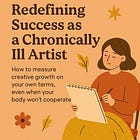I Can’t Create Here: The Invisible Barriers of Space
Your body is not lying. If the room makes you anxious, dissociated, or fatigued, that is data. Your brain may tell you to push through. Your body already knows better.
Have you ever felt like you simply couldn’t work in the room that you were in? I have. Heck, I felt that way about a whole city which is why I moved away from my hometown in order to be able to create.
Some places just never let you exhale. They carry old arguments in the drywall. Their angles feel jagged even when the lines are square. The difficulty of making art is not always about time, talent, or energy. Sometimes, it’s about the room itself. It’s about everything it holds.
Creative space is rarely neutral. It holds memory. It interacts with the nervous system. It either grounds or destabilizes. And when mental health symptoms are present, such as trauma, anxiety, depression, or neurodivergence, its role becomes even more potent.
I have developed these ideas after decades of lived experience, interview-based insights, and deep research into the complex relationship between art and health. They are based on my unique 6-part framework. If you are interested in assistance in applying these ideas to your own life: Order a Creative Health Assessment or Book a 1:1 Coaching Call.
The Room Is Not Empty
When we speak of creative blocks, we often reduce them to psychological patterns like fear of failure, perfectionism, or lack of inspiration. But we overlook how often the block lives in place. A creative space is not just functional. It is relational. It holds history. For some, it also holds harm.
Trauma theory, particularly from somatic psychology, helps explain this. Traumatic memory isn’t stored in narrative sequence. It’s stored in the body. Bessel van der Kolk’s work emphasizes that trauma is not the event itself but the physiological imprint it leaves. This imprint can be activated by seemingly benign cues. A corner of the room. The way light filters through a window. Even the feel of the floor beneath your feet.
This is especially true for those who experienced trauma in their home, workplace, or institutional settings where creativity was shaped or shamed. When a person returns to a space tied to those memories, the nervous system might enter hypervigilance without conscious reason. The room becomes a closed door, not because it is locked, but because the body says NO.
For artists who have pushed through breakdowns in those rooms, produced while dissociating, or used their space as a container for emotional overwhelm, even success can complicate the return. You may finish a project and never want to see that table again. The space remembers who you were when you broke. And that memory lives in the walls.

When Sensation Becomes Disruption
For neurodivergent creatives, sensory input can make or break the relationship to space. Elaine Aron’s research into Highly Sensitive Persons and work from the field of sensory processing disorder describe how minor environmental details can become overwhelming. A cluttered desk is not a nuisance. It’s an attack on coherence. Harsh lighting is not discomfort. It’s dysregulation.
In these cases, space functions more like an extension of the nervous system. When it’s too loud, too bright, or too disordered, the body begins to shut down. You don’t get to choose presence. Your brain reroutes to protection.
This is exacerbated by the contemporary demand for multifunctional environments. Many artists today work in bedrooms, living rooms, or shared offices. These spaces hold competing roles: art studio, Zoom room, rest zone, and therapy container.
One of the artists I have worked with in my 1:1 Healthy Creativity Conversations work speaks to this. She talked about needing her materials visible in order to create, but having to pack them away because the room was also her office. The cognitive load of switching between creative and professional selves in the same square footage can be so taxing it shuts down the desire to create altogether.
In my own life, I’ve rearranged rooms repeatedly. Not out of aesthetics, but survival. Each configuration was a conversation with my body. Does this feel better? Is this less overwhelming? Can I breathe here? These were not decisions of décor. They were strategies of regulation. I’m also a frequent decluttered. Clear the space, clear the mind.
The Politics of Place
Beyond sensory factors, place holds power in another way. It dictates who belongs. Feminist geography and disability studies remind us that space is not just physical. It is political. It determines who gets to feel safe, seen, supported, and who is surveilled, dismissed, or othered.
As I sit here thinking about this, I’m reminded of the interview I did with amazing artist
in which she shares about her experience of harassment:A few years before we moved out of Oklahoma, I had to stop attending art exhibits in Oklahoma – it was either that or stop making art. And I simply couldn’t stop making art.
The place had not only become unsafe. It had become creatively unsustainable. Sue moved. And in that move, her art came back to life.
Creative space is a site of identity. When that identity has been challenged by racism, ableism, fatphobia, classism, or other marginalizations, the space becomes complicit. It may still be yours legally. But it no longer belongs to you somatically. You find yourself doing the mental math. How do I take up less space here? What version of me is safe to bring out?
These calculations shape how we move through space. And they shape what we make.

When the Room Stops Working
There’s grief in outgrowing a creative space. Or in realizing that it no longer fits. Not because of change in square footage, but in self. What once felt sacred becomes unbearable. And we question not the room, but ourselves.
The loss of fit is not failure. It is feedback. And honoring that can be liberating.
In narrative therapy, we talk about spatial metaphor as a clue to self-understanding. If the room feels tight, what narrative is too narrow? If the door won’t open, what part of you has been locked away? Working with clients, I have found myself asking: What would your creative space look like if it loved you back?
The answers vary. Some want plants and texture. Others want walls to speak less. Some need a total reset. Not everyone can afford to move, something I know well with rent the way that it is in San Francisco. But sometimes a symbolic act, such as a chair turned, a window opened, or a scent replaced, can begin the re-authoring of the space.
Creative Space Is a Nervous System Partner
Space is not a backdrop. It is a co-regulator. It shapes your ability to enter creative flow, to risk vulnerability, and to play. When the room becomes a source of constriction rather than expansion, it deserves attention, not judgment.
Your body is not lying. If the room makes you anxious, dissociated, or fatigued, that is data. Your brain may tell you to push through. Your body already knows better.
Creativity flourishes where the nervous system feels held. That doesn’t always mean comfort. Sometimes it means charge or intensity or a bit of edge. But it should not mean dread. It should not mean collapse.
When we create environments that honor our sensory and emotional needs, we are not catering to weakness. We are building conditions for courage. We are saying yes to art that comes not from a forced posture but from a place of truth.
Sometimes, the most radical thing you can do for your practice is to listen to what your space is trying to tell you. And then begin, again, somewhere else.
If you read this far, perhaps you liked the work. The work takes work. Support it if you can:






Such an interesting read - thank you.
Perfect timing! Am in the midst of reconfiguring my creative space, claiming it proudly as I step in to semi retirement and put down my old label of “therapist”. Thanks so much